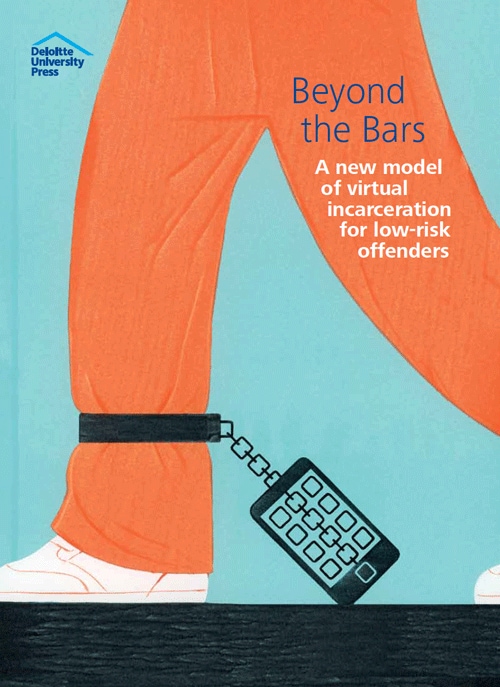
Law and justice: New options for public security The State Policy Road Map: Solutions for the Journey Ahead
07 February 2018
Spending on the criminal justice system has increased at triple the rate of public school funding over the last 30 years. States must address innovative ways to save money while still enhancing public safety. Three emerging areas worthy of consideration are virtual incarceration, streamlined court proceedings and digitized emergency management.
What is the issue?
Perhaps a governor’s most sacred responsibility is his or her commitment to safeguard citizens’ lives and properties. In today’s times—with terrorism and civil unrest often joining crime and disaster response as key citizen concerns—security is typically a top-of-mind priority with voters.
Learn more
View the full collection
Subscribe to receive Public Sector content
View the table of contents and create a custom PDF, or download the full collection
Sign up for the webcast
Justice and security can encompass a broad range of public safety issues, including law enforcement, emergency management, the courts, and homeland security. Constituents want the state to uphold its obligation to protect them and ensure the administration of justice in each of these areas—no easy task.
The costs associated with justice and security are not small. Over the last 30 years, spending on the criminal justice system has increased at triple the rate of public school funding.1
How can governors meet this challenge without breaking the bank? One way is to consider using new technology and new approaches to break traditional trade-offs. Government can look for innovative solutions by expanding the “ideas space” for addressing these thorny challenges.2 Instead of more of the same, approaches such as adopting good ideas from other states or partnering with cutting-edge private sector firms have the potential to save money and enhance public safety.
The possibilities are endless. But there are three areas that seem ripe for new thinking: embracing virtual incarceration, streamlining court proceedings, and digitizing emergency management.
Issue by the numbers: Law and justice
- In the last 40 years, inmates in federal and state correctional facilities have increased by nearly 600 percent, as reported by the Bureau of Justice Statistics (figure 1).

- A study on recidivism found that about two-thirds of released prisoners are rearrested within three years, and three-fourths are rearrested within five years.3
- As of 2015, an inmate in California costs the state an average of $64,642 per year; in New York, the cost per inmate is $69,355 per year.4
- Close to 50 percent of inmates are nonviolent offenders (figure 2).5

How can state leaders tackle the issue?
Virtual incarceration
Many state governments around the country face the problem of a prison system that is too crowded, too expensive, and often doesn’t succeed in reducing recidivism. Over the past 40 years, state and federal prison populations have increased nearly 600 percent,6 and a National Institute of Justice study finds that over 50 percent of inmates are rearrested within one year of their release and 75 percent are rearrested within five years.7
Women constitute one of the fastest-growing prison populations, increasing from 8,000 in 1970 to 110,000 in 2014.8 This is an incredible 1,300 percent increase, four times the increase rate of male prisoners. As one can imagine, this isn’t the sort of growth that states want to see, and it certainly doesn’t come cheap. The impact isn’t just budgetary; incarceration can have an immense impact on children, families, and communities.
One potential solution is virtual incarceration, which could use an Internet of Things (IoT) device for certain low-risk, nonviolent offenders. Instead of going to a physical jail or prison, convicted persons could remain in their communities or in some sort of low-cost shared housing—either of which would permit them to maintain family connections, jobs, and support systems while serving time—while their location is monitored with GPS-enabled devices that alert authorities if the wearer moves out of a specific geographic area. This technique would limit inmates’ freedom of movement by confining them to specific geographic locations; in essence, it would be a form of house or community arrest, which could be expanded from its primary present-day use as a pretrial confinement tool to one that supplants physical incarceration. This system—elements of which are already being used in a number of states—can be expanded to include advanced risk modeling, geospatial analytics, smartphone technology, and principles from the study of human behavior to achieve superior outcomes at a lower cost.9
 Learn more about virtual incarceration in Beyond the bars: A new model of virtual incarceration for low-risk offenders. |
Evidence suggests that this sort of program could save states significant amounts of money—and could be even more effective than traditional imprisonment. A 2012 study of electronic monitoring devices in Washington, DC, found a drop in recidivism by 24 percent and an overall net benefit to society of $4,800 per person across the criminal justice system.10 And in Florida, virtual incarceration reduced the failure rate of offender compliance with probation terms by 31 percent.11
Unresolved questions surrounding the ethics of virtual incarceration remain, including when it is appropriate and whether those being monitored should be charged for the use of the devices. But state government can explore this technology as a potential way to reduce prison overcrowding and recidivism, decrease the budgetary burden, and improve the chances of rehabilitation. That said, technology alone likely won’t be enough. Coupling these programs with counseling, skills training, and work transition programs can help head off issues early and assist in getting offenders the right help to keep them on track.
Speedy trials
Courts are where the laws of the state and the rights of the citizenry meet. The Sixth Amendment to the US Constitution grants citizens the right to a speedy trial, and if courts become an inefficient vehicle for the delivery of justice, the resulting problems can extend far beyond the justice system. Research has shown that one of the most effective means of deterring criminal behavior, or recidivism in the case of probationers, is to implement “swift and certain” punishment.12
An example of this approach’s success is found in Hawaii’s Opportunity Probation with Enforcement (HOPE). This program provides convicted persons and probationers a set of guidelines that govern their daily reporting requirements to state officials. If the agreed-upon rules are broken, punishment is swift, certain, and “sends a consistent message about personal responsibility and accountability.” This concept revolves around the idea that citizens respond better to certainty than severity. The results seem promising: 61 percent are less likely to miss supervisory appointments, 72 percent are less likely to use drugs, 55 percent are less likely to be arrested for a new crime, and 53 percent are less likely to have their probation revoked. 13
Another approach is the use of new technologies and innovation competitions that crowdsource solutions from outside the courts. For example, in 2014, the city of Philadelphia launched a $100,000 challenge called FastFWD that invited entrepreneurs, businesses, and academics to develop innovative solutions to crime and justice. “We wanted to open up the solution space,” explains Story Bellows, who led the initiative for the city.14
And in North Carolina, an electronic filing system at local assistance centers allows victims of domestic abuse to file a complaint, provide sworn testimony via webcam, issue a summons, automatically index the case, and transmit protective orders to all parties. A process that used to require time and travel to several locations can now be accomplished in one trip and 90 percent faster.15
Opening systems to external ideas has the potential added bonus of an engaged citizenry that feels some sense of ownership of its institutions, and the use of performance data to identify procedural flaws can help spur efforts to resolve those issues. Ultimately, more efficient administration of the court system can improve outcomes, reduce state prison and tax costs, and perhaps strengthen the constituency’s faith in the state’s ability to protect and serve.
 Read more about collaborative approaches to law and justice in A solution economy for justice reform. |
Digitizing emergency management
Some of the toughest security challenges a governor can face are emergency situations that occur with little or no warning. While certain natural disasters, such as hurricanes, are foreseeable, others, such as tornadoes, provide little warning. A peaceful protest can quickly escalate into a riot, and an act of terror can occur in the unlikeliest of places at any time. State government must be ready to respond quickly and coordinate all the resources of the emergency response.
Between 2005 and 2015, the Federal Emergency Management Agency spent $67.7 billion to assist communities devastated by natural disasters, including winter storms, tornadoes, and wildfires.16 And this cost doesn’t account for lost productivity and revenue streams, emergency state expenditures such as overtime and National Guard activation, or the immeasurable loss some communities suffer. While few governors campaign on a platform of better disaster response, failure in this area can define an administration.
While this task can become overwhelming, having the right tools ahead of time can better prepare state governments to be more resilient and recover more quickly. Here again, leveraging IoT devices and the power of data collection can prove invaluable.
Some states are already using advanced analytics to more efficiently respond to severe weather—techniques that could be extended to disaster response. Saginaw County, Michigan, for example, now uses data analytics to improve the efficiency of salt trucks preparing roadways for snowstorms, and has saved over $500,000 by reducing salt use. Keeping the public informed during a disaster is important, and in 2016, locals of Howard County, Maryland, could see exactly which streets had been plowed on a website that could be viewed through their mobile devices. Additionally, the website displayed relevant data, such as “highway traffic camera views, weather alerts, and real-time traffic information”—providing residents with a one-stop shop for storm recovery information.17
From these early applications to address inclement weather, it is not a huge leap to consider how advanced analytics could be used to improve other aspects of emergency response services. The same technology that efficiently stations snowplows can be used to position police (as is already being done in Santa Cruz, California),18 firefighters, or ambulances. In this way, advanced data analytics can transform the way governors are able to manage emergency responses to better keep their citizens safe. In fact, in a more distant future, augmented reality (AR) could allow agencies to enhance search and rescue efforts. From using virtual compasses to trace the direction of a target location to three-dimensional mapping of the surrounding environment, AR capabilities could improve and aid emergency management in a big way. 19
You don’t have to look too far for inspiration
Using geospatial mapping to micro-target reentry programs and services in New York City
For more than a decade, New York City’s Justice Mapping Center has tracked the residential addresses of inmates in various prison systems—the address they gave when they went into prison. The center found that offenders often are concentrated in particular census blocks, some of them costing state and local governments more than $1 million a year in incarceration costs alone.20 Such findings are spurring some cities around the nation to design reentry initiatives for specific neighborhoods, with services such as transitional housing and job training for ex-offenders.
© 2021. See Terms of Use for more information.





